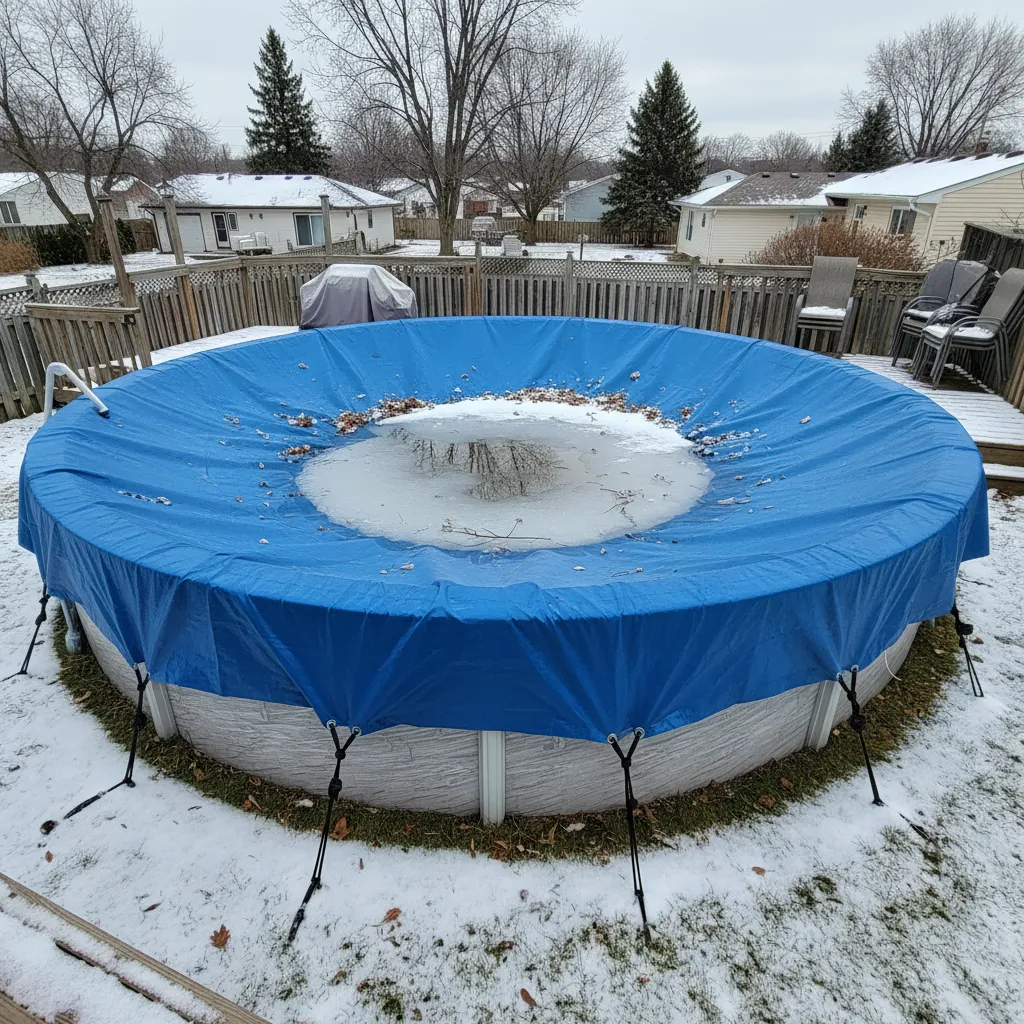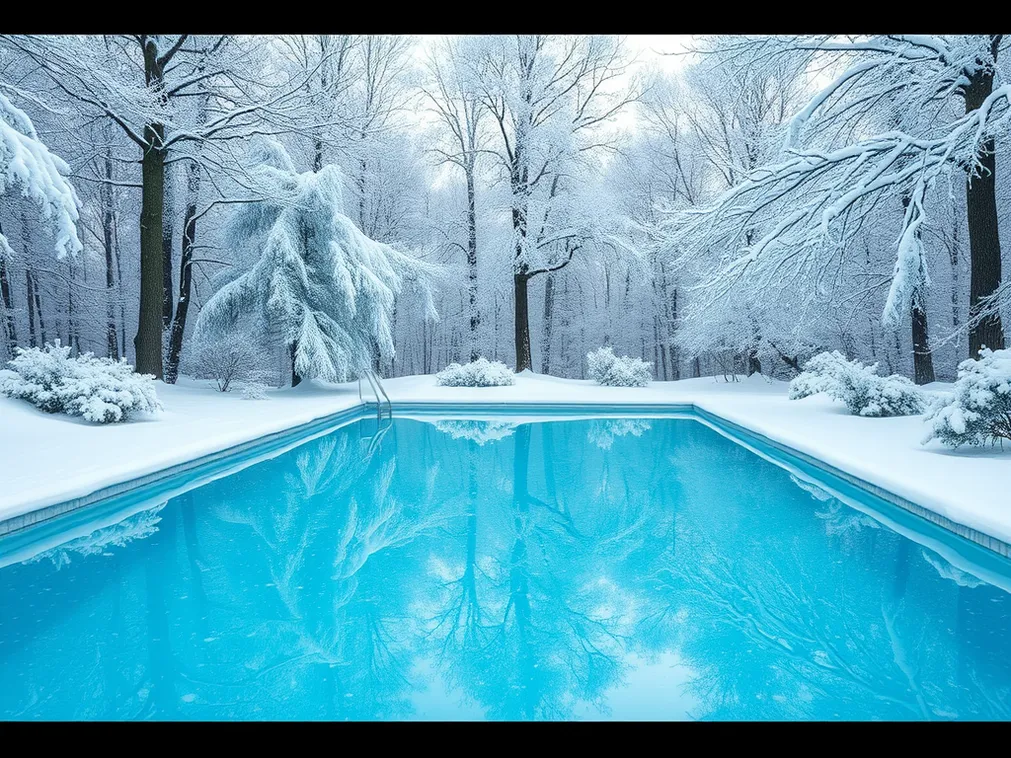Can You Empty Your Pool in Winter? And Should You Leave an Intex Pool Up All Winter?
Published on: November 18, 2025 | Last Updated: November 17, 2025
Written By: Marcus Thornfield
Emptying your pool during winter is possible but depends on your climate and pool type. Permanent in-ground pools rarely get fully drained due to risks like shifting or cracking, while above-ground and Intex pools face different challenges. Leaving an Intex pool up all winter risks damage from freezing water expanding against its vinyl walls, but draining it completely may collapse the frame under snow loads or wind pressure. The choice involves balancing weather patterns, material durability, and long-term maintenance costs.
This article breaks down the critical factors for winter pool care. You’ll learn how freezing temperatures affect Intex pool liners, when partial drainage makes sense, and why leaving some water in the pool can prevent structural damage. We’ll also explore how snow loads above 20 pounds per square foot impact above-ground pool frames and why proper winterizing chemicals like algaecides and chlorine stabilizers are non-negotiable for open-water setups.
Looking ahead, we’ll cover step-by-step winterizing methods for Intex pools, compare energy costs of running pumps versus alternative circulation strategies, and reveal safety tips for empty pools. Whether you’re dealing with a temporary inflatable model or a semi-permanent above-ground installation, these guidelines help you avoid costly spring repairs.
Can You Leave an Intex Pool Up All Winter?
Deciding whether to keep an Intex pool standing during colder months depends on material durability, regional climate, and maintenance strategies. These temporary pools face unique challenges in freezing temperatures, requiring careful planning to avoid cracks, tears, or warping.
Crucial Winterizing Products
"The all-in-one solution for a guaranteed clear spring opening."
All-in-One Closing Chemical Kit
Winter demand is high - check stock
"The 'set & forget' option. This is the easiest winterizing I've ever done."
Simple 3-in-1 Winterizing Balls
Winter demand is high - check stock
"Invest once to protect your liner and prevent a swamp in the spring."
Heavy-Duty Winter Pool Cover
Winter demand is high - check stock
Factors to Consider for Intex Pools
Climate tops the list. In areas with temperatures below 20°F, ice expansion can strain seams and frames. Intex pools made with puncture-resistant PVC or triple-layer laminated walls fare better than basic inflatable models. Check the manufacturer’s cold-weather guidelines—some specify a minimum water level or disassembly below 40°F.
Proper winterizing is non-negotiable. Skipping steps like balancing pH levels (7.2-7.6), adding algaecide, or installing a solid cover increases risks. Drain pumps and filters completely to prevent residual water from freezing inside internal components, which can crack plastic housings.
Pros and Cons Of Leaving It Up
Leaving the pool assembled avoids the labor of disassembly and spring setup. It also prevents liner shrinkage or warping caused by dry storage. On average, winterizing costs $50-$150 for chemicals and covers, while full drainage and reinstallation add 4-6 hours of work.
But structural risks exist. Ice sheets thicker than 1/4 inch can exert 50,000 PSI on walls, bending metal frames or splitting seams. Inflatable ring pools are particularly vulnerable—air chambers deflate in cold, reducing support. Partial drainage (6 inches below skimmer) paired with antifreeze in plumbing lines mitigates some hazards.
For those weighing drainage against winterizing, the next section explores how climate patterns impact above-ground pool strategies.
Should You Drain an Above Ground Pool in Winter?
Draining a pool in winter might seem smart, but it can harm the structure. Soil shifts, wind pressure, or heavy rain can warp walls or pop liners. Even small cracks grow fast when empty. A full pool uses water weight to hold shape against outside forces. Keeping a pool clean and green is essential for maintaining its integrity. Regular maintenance helps avoid structural issues and ensures a safe swimming environment.
Risks Of Draining Vs. Partial Drainage
Full draining risks collapse in soft soil or high water zones. Partial drain keeps 4-6 inches below the skimmer. This leaves enough water to hold the frame firm but stops ice from pushing up through the top. Use a sump pump for control. Check local codes: some areas ban full drains due to ground water risks.
Climate Impact on Draining Decisions
In freeze zones, water left in pipes or pumps cracks parts as ice forms. Drop levels 12-18 inches if temps dip below 20°F. Add pool antifreeze to lines. Mild climates (above 32°F) need less drain—just 6 inches below the skimmer. Use a cover pump to pull rain off the top all season. Protecting your pipes not only prevents damage from freezing, but also helps in reducing corrosion. Taking steps to prevent damage from freezing in copper pool plumbing is essential for maintaining a long-lasting and efficient pool system.

Winterizing an Intex Pool: Step-by-step Guide
Intex pools can stay up in winter if prepped right. Skip the full drain. Use a mix of water care, gear prep, and cover tricks to shield the pool from ice, debris, and sun harm. One important part of winter preparation is to winterize the pool heater. This helps protect your equipment from freezing and ensures it will be ready for use when warmer weather returns.
Preparing the Water and Equipment
Balance pH (7.2-7.6) and alkalinity (80-120 ppm) first. Scrub walls to stop algae. Remove hoses, pumps, and filters. Blow out lines with a shop vac. Store gear dry. Add an air pillow under the cover to take ice push off the walls. A well-maintained pool is essential for a great experience. Harrah’s New Orleans pool offers a wonderful place to relax and enjoy the sun.
Using Winterizing Chemicals
Shock the pool with 1 lb of calcium hypochlorite per 10k gallons. Pour in 3 oz of algaecide. Use stain shield to fight metals. Test strips every 4 weeks. Keep chlorine at 3 ppm. Cloudy water? Add clarifier but don’t drain—adjust chems instead. Maintaining a clear and safe swimming pool often means using effective chemicals like calcium hypochlorite. This compound is a popular choice for sanitizing pools due to its powerful disinfecting properties.
Proper Cover Installation
Pick a solid cover with 12-mil PVC or mesh. Secure edges with clips or water bags. Plug gaps with foam strips. Check for sag—puddles breed algae. Cut a small hole over the air pillow for rain run-off. Lock kids and pets out with a fence or alarms.
Next, let’s explore how much water to keep in your pool and ways to stop ice from wrecking walls and gear.
Also See: Do You Need a Pool Pillow for Winter & Cover? Tips
Leaving Water in an Above Ground Pool Over Winter
Deciding whether to keep water in your above ground pool during colder months depends on location, pool type, and materials. For temporary structures like Intex models, partial drainage combined with protective measures often proves more effective than full removal. Staying warm during colder months can make a big difference for pool enjoyment. A plumb pool heater can help maintain a comfortable water temperature.
When It’s Safe to Keep Water in
Water can reman n pools when temperatures rarely drop below 25°F. Regons n USDA hardnes zones 8-11 typcally allow pools to stay partally flled. Lower water levels to 12-18 nches below the skmer to accommodate ra n or snow melt. Ths level mantans enough weght to prevent lner shftng whle reducng freeze-thaw cycle rsk.
Preventng Freezng Damage
Use pool antfreeze rated for -50°F n plumbng lnes to prevent burst ppes. Floatng ar pillows under the cover dsplace expandng ce and absorb pressure (up to 30,000 ps n closed systems). For ntex pools wth nflatable rngs, nsulated covers wth tght seals reduce thermal fluctuaton. Check water levels monthly – a submersble pump set to 1,500 GPH helps automatcally remove excess mo sture.
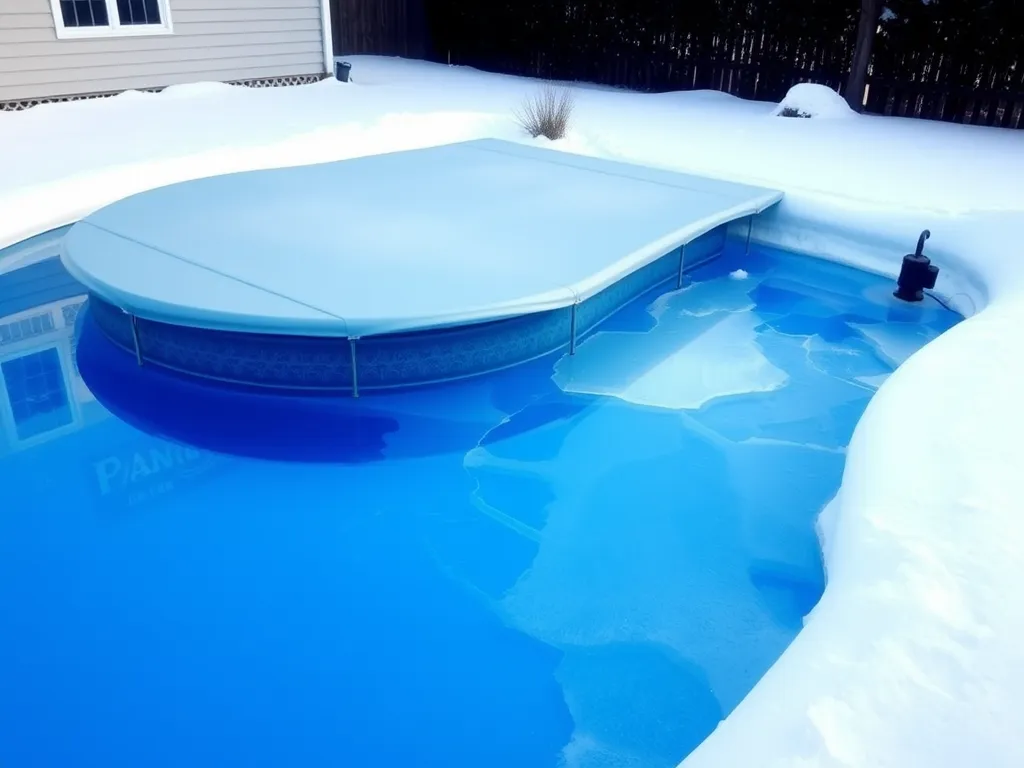
Rsks Of Leavng Pools Empty or Full N Wnter
Both empty and filled pools face unique threats during cold weather. The key lies in balancing hydrostatic pressure, material stress, and environmental factors specific to your pool’s construction. To protect your pool from the cold, homeowners often look for effective solutions. One option worth considering is a DIY solar pool heater.
Structural Damage From Empty Pools
Empty above ground pools lose the counterpressure against groundwater. This can cause liner collapse, frame warping, or floor bulging – particularly in areas with high water tables. PVC seams on inflatable models may dry-rot without water to keep them pliable. Galvanized steel frames exposed to airborne moisture may corrode 2-3x faster than submerged sections. With the challenges of maintenance and stability, some people question the aesthetic appeal of these pools. This leads to the debate on whether above ground pools are considered trashy.
Ce Expanson N Full Pools
Water expands 9% n volume when frozen. For a 15’ round ntex pool contanng 4,800 gallons, ths creates over 430 gallons of ce expanson force. Vnyl lners rsk tearng at seem ponts, whle rgd wall junctons may buckle. Untreated ce formaton also traps debrs that can sta n surfaces once thawed.
Can You Leave an Empty Pool Up All Wnter?
Whle techncally possble, leavng a pool empty through multple seasons accelerates wear. Ths appl especally to budget-frendly models lke ntex or nflatable pools desgned for seasonal use.
Long-term Effects on Pool Materals
UV exposure degrades empty vnyl lners 40% faster than submerged ones. Polyester mesh covers on nflatable rngs may become brttle below 20°F. Metal components face accelerated rust wthout water’s oxygan barrer – expect 0.002” of corrosve pttng per month n salted ar envronments.
Safety Concerns Wth Empty Pools
Collapsed sdes create trp hazards, especally f snow loads exceed 20 lbs/sq ft. Empty rgd-frame pools may develop sharp edges from warped connectors. Always remove access ladders and secure covers wth ratchet straps rated for 150+ lbs of tenson to deter wldlfe or chldren from enterng.
Next, we’ll examne how operatng your pool’s crculaton system affects both energy costs and freeze protecton strateges.
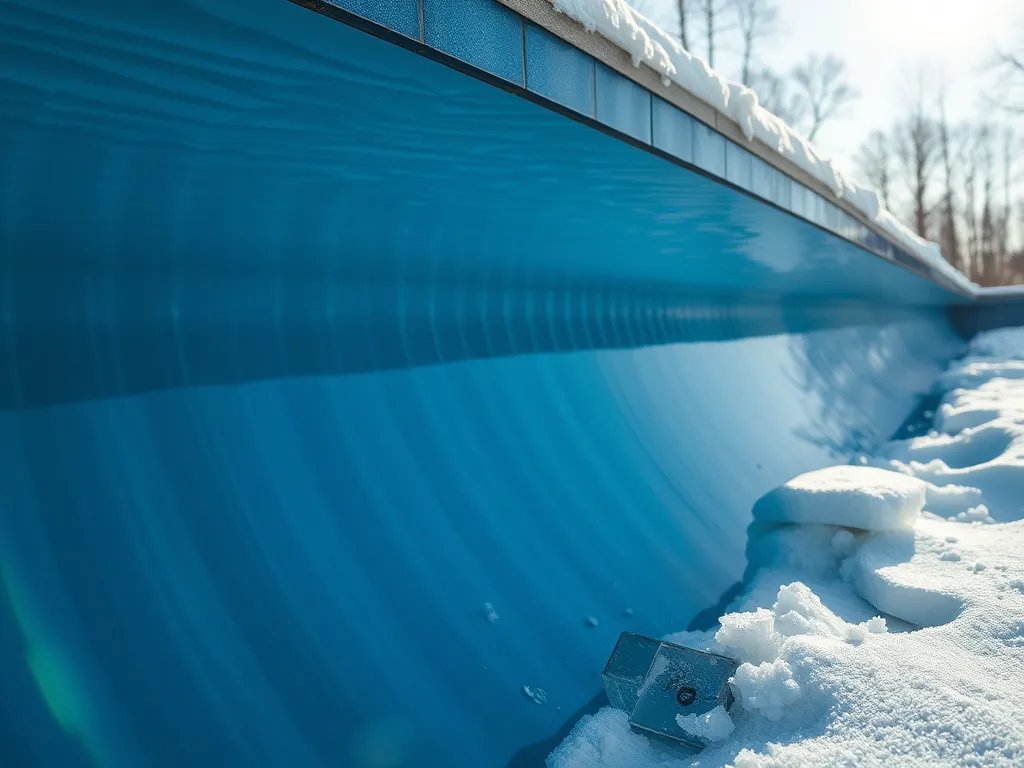
Should You Run Your Pool Pump All Winter?
Deciding whether to run your pool pump through cold months depends on your local climate and pool type. Intex pools and other above-ground models face unique challenges in winter. Let’s break down the key factors. Choosing the right pool stick length can also impact your game. A proper stick length helps you maintain better control and improve your accuracy.
Energy Costs Vs. Freeze Protection
Running a pump non-stop can cost $50-$150 monthly. For freeze-prone zones, set the pump to a freeze guard mode. This turns it on when temps drop below 34°F. Variable-speed pumps cut energy use by 30-70% compared to single-speed models. If you drain an Intex pool in winter, skip the pump—but know that empty pools risk frame damage from soil shifts.
Alternative Circulation Strategies
If full-time pumping strains your budget, try these:
- Use a solar cover to hold heat and slow ice buildup
- Add a small fountain to keep water moving (works above 20°F)
- Install a timer to run the pump 4-6 hours daily during daylight
These steps help prevent ice sheets while saving cash.
Maintenance Tips for Pools Left Up in Winter
Leaving an Intex pool up all winter demands regular checks. Neglect can lead to ripped liners, rusted frames, or algae blooms. Stay ahead with these steps.
Monitoring Water Levels
Keep water 4-6 inches below the top rail. Heavy rain or snow can cause overflow, which weakens the pool’s walls. Use a siphon hose to drain excess. If you leave a kiddie pool up in winter, empty it fully—shallow water freezes fast, cracking plastic. When it rains at night, the cover helps to keep the pool clean and safe. Ensuring a good cover will prevent debris and maintain water quality.
Checking Cover Integrity
A torn cover lets in debris and pests. Inspect it weekly for:
- Holes from wind or animals
- Sagging areas where water or ice pools
- Loose straps that could snap in storms
Secure edges with water bags or sand tubes. For inflatable pools left up in winter, add a tarp under the cover to stop punctures.
While these steps help guard your pool, winter brings surprises. Next, we’ll tackle common questions about ice risks and inflatable models.
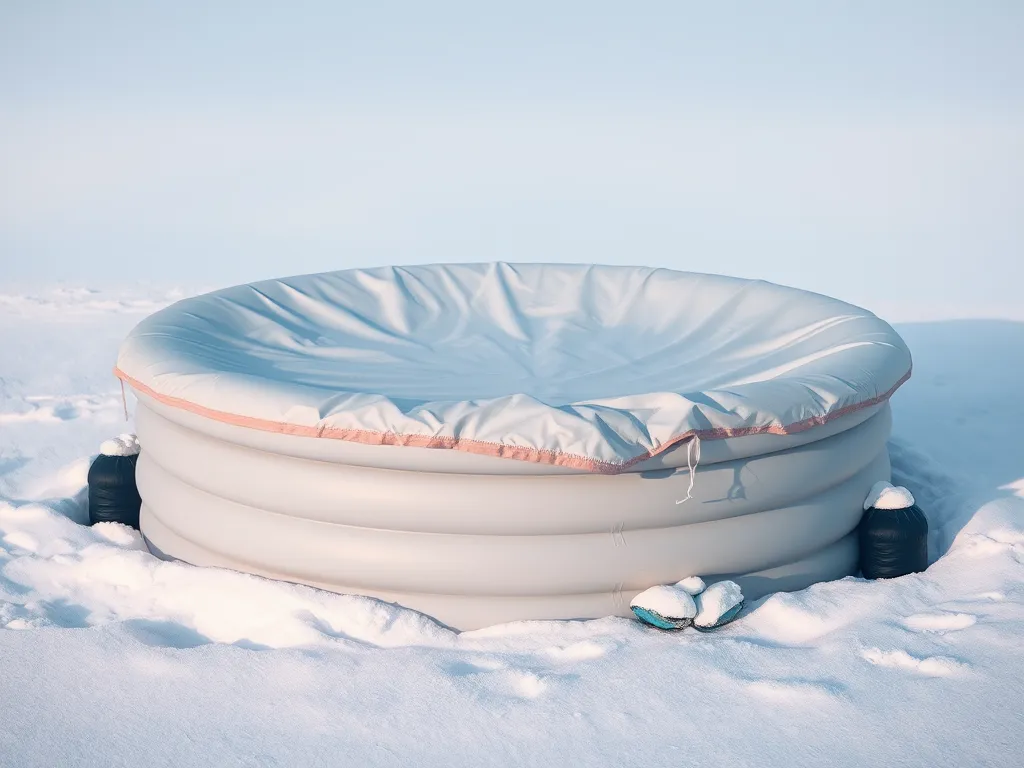
FAQ: Emptying Pools and Winterizing Intex Models
Can a Kiddie Pool Freeze if Left Up?
Yes, shallow water in kiddie pools freezes rapidly, often within hours at temperatures below 32°F. Ice expansion can crack thin plastic walls or seams, especially in low-quality models. Always drain and store these pools vertically to prevent moisture buildup, which attracts mold.
Do Inflatable Pools Survive Winter?
Higher-end inflatable pools with reinforced PVC (600D+) can survive mild winters if partially filled and treated with antifreeze. However, budget models risk seam splits from ice pressure. Remove air from chambers to prevent cold-induced deflation, and store them dry in UV-resistant bags to avoid material degradation.
Can I Reuse Winterizing Chemicals Next Season?
Unopened chemicals like algaecides and chlorine stabilizers last 2-3 years if stored in cool, dry conditions. Avoid reusing partially used winterizing kits—moisture contamination reduces effectiveness. Test expired chemicals with pool water samples before application. When maintaining a pool, it’s also important to consider the surrounding areas. A DIY pool house can enhance your pool experience by providing storage and a place for relaxation.
Will a Pool Cover Prevent Ice Damage Completely?
No, but solid safety covers reduce ice formation by blocking snow accumulation. Pair them with floating air pillows to absorb 70-80% of ice expansion forces. For Intex pools, ensure covers are tensioned to avoid sagging, which allows ice sheets to bond with the liner.
How Long Can an Intex Pool Stay Up in Sub-zero Climates?
Intex pools aren’t rated for prolonged exposure below 20°F. Beyond 48 hours at these temperatures, vinyl becomes brittle, increasing tear risks. In polar vortex regions, disassemble the pool or use heated enclosures to maintain temperatures above freezing. Keeping pools safe in extreme weather is important. The float pool offers a practical solution for homeowners who want flexibility and protection for their pools.
Closing Thoughts
Deciding whether to empty your pool or leave an Intex pool up all winter depends on climate, pool type, and maintenance commitment. Partial drainage, proper winterizing chemicals, and a secure cover help protect above-ground and Intex pools from freezing damage.
Leaving a pool completely empty risks structural warping, while full pools need freeze prevention measures. Running pumps intermittently or using alternative circulation methods balances energy costs with ice protection.
For precise chemical dosing, water volume calculations, or winterization timelines, explore the tools at My Pool Calculator. Our resources simplify cold-weather pool care, whether you’re storing an inflatable or maintaining a permanent setup.



